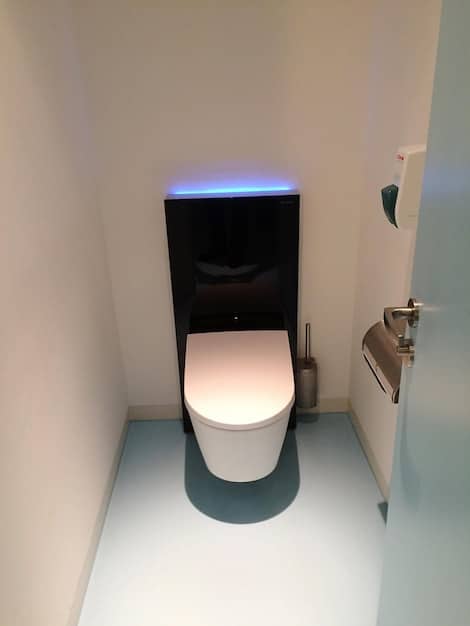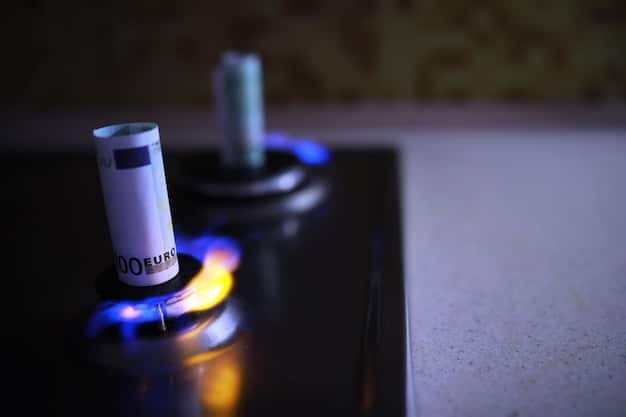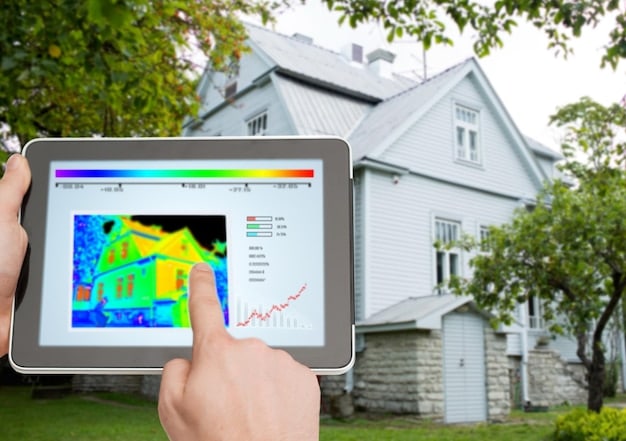Smart Home Sensors: Prevent Water Damage & Save Money

Smart home sensors can detect leaks early, preventing costly water damage and high water bills, offering peace of mind and potential insurance benefits.
Water damage can be a homeowner’s worst nightmare, leading to expensive repairs and potential health hazards. Fortunately, smart home sensors offer a modern solution for water leak detection, allowing you to catch problems early and prevent catastrophic damage.
Understanding the Threat: Why Water Leak Detection Matters
Water leaks, even small ones, can cause significant damage over time. From mold growth to structural issues, the consequences can be severe and costly. Understanding the risks is the first step towards protecting your home.
The Hidden Dangers of Water Leaks
Many water leaks occur behind walls, under floors, or in other hidden areas. These leaks can go unnoticed for weeks or even months, leading to extensive damage before you realize there’s a problem.
The Financial Impact of Undetected Leaks
Beyond the cost of repairs, undetected leaks can also lead to significantly higher water bills. Even a small drip can waste gallons of water over time, adding up to a substantial financial burden.

Here are some examples of the types of problems that can be detected early with smart home sensors:
- Leaky Faucets & Toilets: Detects drips before they escalate to major floods.
- Appliance Malfunctions: Alerts you to issues with washing machines, dishwashers, and water heaters.
- Pipe Bursts: Provides immediate notification of significant water flow outside of normal usage.
Therefore, proactive water leak detection is crucial for maintaining your home’s integrity and protecting your finances.
How Smart Home Sensors Work: A Technological Overview
Smart home sensors for water leak detection use various technologies to monitor moisture levels and water flow. These devices connect to your home’s Wi-Fi network, allowing you to receive alerts directly to your smartphone or other devices.
Types of Water Leak Sensors
There are two main types of water leak sensors. Spot detectors are placed near potential leak sources and trigger an alarm when moisture is detected. Whole-house systems monitor water flow and pressure, identifying unusual patterns that may indicate a leak anywhere in your home.
Connectivity and Alert Systems
Most smart home sensors connect to your home’s Wi-Fi network and send alerts via smartphone apps, email, or text message. Some systems also integrate with smart home hubs, allowing you to automate water shut-off valves and other responses.

Here are key features found in effective smart home sensor technology:
- Real-time Monitoring: Constant tracking of water activity in your home.
- Customizable Alerts: Set up alerts based on your specific needs and concerns.
- Remote Shut-Off: Some systems allow you to remotely shut off your main water supply.
Understanding how these sensors work empowers you to choose the right system for your home and effectively monitor for water leaks.
Placement Strategies: Where to Install Water Leak Sensors
Strategic placement of smart home sensors is essential for effective water leak detection. Focus on areas with a high risk of leaks, such as near plumbing fixtures, appliances, and in basements.
High-Risk Areas for Water Leaks
Key areas to consider include under sinks, behind toilets, near washing machines and dishwashers, around water heaters, and in basements or crawl spaces. Also, check areas prone to moisture, like windows and exterior walls.
Optimizing Sensor Coverage
Consider the range and coverage area of your smart home sensors. For larger homes, you may need multiple sensors to ensure adequate protection. Ensure proper placement following the manufacturer’s instructions.
Ideal locations for smart sensors include:
- Bathrooms: Under sinks, behind toilets, and near showers.
- Kitchens: Under the sink, near the dishwasher, and around the refrigerator.
- Laundry Rooms: Near the washing machine and water connections.
Careful planning and strategic sensor placement will maximize the effectiveness of your water leak detection system.
Choosing the Right Sensors: Features and Considerations
Selecting the right smart home sensors requires careful consideration of factors like price, features, battery life, and compatibility with your existing smart home ecosystem.
Key Features to Look For
Look for sensors with features like water flow monitoring, temperature sensing, remote shut-off capabilities, and integration with other smart home devices. Ensure the system is user-friendly and offers reliable notifications.
Comparing Different Brands and Models
Research different brands and models to find the best fit for your needs and budget. Read customer reviews and compare specifications to make an informed decision. Consider brands known for reliability and customer support.
When considering different brands, check for:
- Battery Life: How often do you need to replace or recharge batteries?
- Connectivity: Does the sensor work with your existing Wi-Fi or require a hub?
- Alert Options: How will you be notified of leaks (app, email, text)?
Careful comparison will help you select the smart home sensors that provide the best protection and value for your specific needs.
Installation and Maintenance: Setting Up Your System
Installing and maintaining your smart home sensor system is crucial for ensuring its continued effectiveness. Most systems are relatively easy to install, but proper setup and regular maintenance are essential.
Step-by-Step Installation Guide
Follow the manufacturer’s instructions carefully when installing your sensors. Ensure proper placement and secure connections. Test the system thoroughly to verify that it’s working correctly.
Regular Maintenance and Testing
Check your sensors regularly to ensure they are functioning properly. Replace batteries as needed and clean the sensors to remove any buildup of dust or debris. Test the system periodically to verify that alerts are being sent correctly.
Maintenance recommendations often include:
- Battery Checks: Replace batteries annually or as needed.
- Sensor Cleaning: Wipe down sensors to remove dust or moisture.
- System Testing: Periodically trigger the sensors to ensure alerts are functional.
Proper installation and regular maintenance will keep your smart home sensor system functioning effectively and providing reliable water leak detection.
The Benefits of Smart Leak Detection: Savings and Security
Investing in smart home sensors for water leak detection offers numerous benefits, including significant cost savings, increased security, and greater peace of mind.
Preventing Costly Water Damage
Early detection of water leaks can prevent extensive damage to your home, saving you thousands of dollars in repair costs. By catching problems early, you can avoid mold growth, structural damage, and other serious issues.
Reducing Water Bills
Smart home sensors can help you identify and fix hidden leaks that are driving up your water bill. By addressing these leaks promptly, you can reduce your water consumption and save money on your monthly bill.
The advantages include:
- Lower Insurance Premiums: Some insurance companies offer discounts for homes with leak detection systems.
- Increased Home Value: Smart home features can make your home more attractive to potential buyers.
- Environmental Benefits: Reducing water waste helps conserve a valuable resource.
Ultimately, investing in smart home sensors provides a valuable return on investment, offering both financial savings and enhanced home security.
| Key Point | Brief Description |
|---|---|
| 💧 Early Leak Detection | Detects leaks early, preventing major water damage. |
| 💰 Cost Savings | Reduces water bills and prevents costly repairs. |
| 📱 Remote Monitoring | Allows monitoring from anywhere via smartphone. |
| 🛡️ Enhanced Security | Provides peace of mind with 24/7 monitoring. |
Frequently Asked Questions
▼
Place them near potential leak sources, like under sinks, behind toilets, near appliances, and in basements.
▼
They detect moisture or unusual water flow and send alerts to your smartphone or other devices via Wi-Fi.
▼
They prevent costly water damage, reduce water bills, and offer enhanced security by detecting leaks early.
▼
Test your sensors regularly, at least every few months, to ensure they are functioning correctly.
▼
Some insurance companies offer discounts for homes equipped with water leak detection systems, so check with your provider.
Conclusion
Smart home sensors for water leak detection offer a proactive solution for protecting your home from costly water damage. By investing in these devices and implementing strategic placement and maintenance, you can enjoy peace of mind and significant savings.





